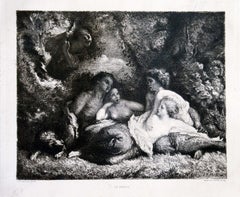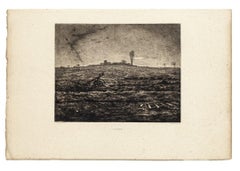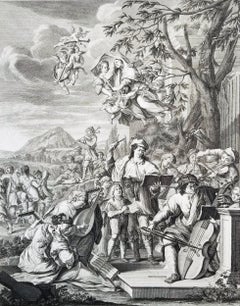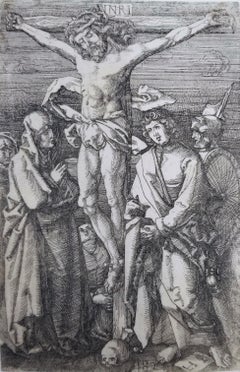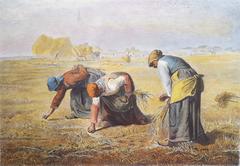(after) Jean François Millet Figurative Prints
French, 1814-1875
Jean-François Millet (1814–1875) was a French painter and a founding member of the Barbizon school, renowned for his depictions of peasant life and rural landscapes. Born in Gruchy, Normandy, Millet hailed from a prosperous farming family and received a solid education before apprenticing under a painter in Cherbourg in 1833. By 1837, he moved to Paris to study at the École des Beaux-Arts under Paul Delaroche. Dissatisfied with academic conventions, Millet developed his own style, focusing on scenes of rural laborers and countryside life. In 1849, he settled in Barbizon, where he created some of his most iconic works, such as "The Gleaners" and "The Angelus." Millet's portrayal of the dignity and hardship of peasant life significantly influenced later artists, including Vincent van Gogh.to
2
Overall Width
to
Overall Height
to
1
10
858
382
376
308
2
2
2
1
1
1
1
1
2
1
1
Artist: (after) Jean François Millet
Le Repos - Original Etching and Aquatint by Marcel Roux - Late 19th Century
By (after) Jean François Millet
Located in Roma, IT
Le Repos
Etching and Aquatint on vélin de Rive paper. Image Dim: cm 20 x 24, Sheet Dim: cm 29 x 44, Passepartout Dim: cm 34 x 49. Signed on plate “J. F. Millet” right-lower.
Wonderful artwork by the French engraver Marcel Roux...
Category
Late 19th Century Naturalistic (after) Jean François Millet Figurative Prints
Materials
Etching, Aquatint
Novembre - Original Etching by Marcel Roux After J.F. Millet -Late 19th Century
By (after) Jean François Millet
Located in Roma, IT
Novembre is an original print in etching technique on ivory paper, realized by Marcel Roux, an engraver and sculptor, after J.F. Millet (French Painter, 18...
Category
Late 19th Century Old Masters (after) Jean François Millet Figurative Prints
Materials
Etching
Related Items
Vespera; Der Abend (Evening; The Evening) /// Johann Daniel Preissler Old Master
Located in Saint Augustine, FL
Artist: (after) Johann Daniel Preissler (German, 1666-1737)
Title: "Vespera; Der Abend (Evening; The Evening)"
Portfolio: Die Vier Tageszeiten (The Four Times of Day)
Year: 1723
Medium: Original Etching and Engraving on laid paper
Limited edition: Unknown
Printer: likely Johann Balthasar Probst, Augsburg, Germany
Publisher: Jeremias Wolff (Erben), Augsburg, Germany
Reference: Le Blanc No. 255, 38; Nagler No. 23
Sheet size: 22.5" x 16.63"
Image size: 17.38" x 13.63"
Condition: Soft handling creases and folds to sheet. Some scattered foxmarks in left margin. Two small tears skillfully repaired from verso in margins. Has been professionally stored away for decades. It is otherwise a strong impression in good condition with full margins
Extremely rare
Notes:
Provenance: private collection - Aspen, CO. Engraved by German artist Johann Balthasar Probst (1673-1750) after a drawing by German artist Johann Daniel Preissler (1666-1737). Comes from Preissler's 1723 "Die Vier Tageszeiten (The Four Times of Day)" portfolio of four etchings and engravings. Printed from one copper plate in one color: black. Descriptions of the portrayed image are printed in Latin and German.
Biography:
Johann Daniel Preissler, or Preisler (1666–1737) was a German painter and director of Nuremberg's Academy of Fine Arts. He was a notable member of a German artistic family, originating in Bohemia. His children included Johann Justin Preissler (1698–1771), Georg Martin Preisler (1700–1754), Barbara Helena Preisler (1707–1758; married to Oeding), Johan Martin Preisler (1715–1794), and Valentin Daniel Preisler (1717–1765), all in their time renowned artists. Most notable for his portraits, nudes and history paintings, Johann Daniel Preissler also produced drawings and frescoes. He was particularly known beyond his native Nuremberg for his "Die durch Theorie erfundene Practic", a sequence of works on art theory – the individual works were translated into several other languages and served as textbooks for students such as the Swiss Salomon Gessner...
Category
1720s Old Masters (after) Jean François Millet Figurative Prints
Materials
Laid Paper, Engraving, Etching
$900
H 22.5 in W 16.63 in
The Crucifixion (Christ on the Cross) /// Jesus after Albrecht Dürer Old Masters
Located in Saint Augustine, FL
Artist: Lambrecht Hopfer (German, Active c. 1525-1550)
Title: "The Crucifixion (Christ on the Cross)"
Portfolio: (after) The Engraved Passion
*Issued unsigned, though monogram signed by Hopfer in the plate (printed signature) lower right
Circa: 1530 (second state of three, published c. 1690)
Medium: Original Etching on laid paper
Limited edition: Unknown
Printer: The Hopfer family, Augsburg, Germany; (David Funck, Nuremberg, Germany)
Publisher: The Hopfer family, Augsburg, Germany; (David Funck, Nuremberg, Germany)
Reference: Bartsch No. VIII.527.12; Hollstein No. 12.II
Framing: Recently framed, the sheet is floated over, and top-matted with a 100% cotton fabric rag mat from Holland in a wood moulding and Museum glass
Framed size: 14.88" x 13.88"
Sheet size: 5.5" x 3.63"
Condition: Trimmed to platemark. A few tiny professional repairs: at elbow of Jesus's right arm and the inside thigh of Jesus. Some light skinning upper right corner and lower right area. It is otherwise a strong impression in good condition
Very rare
Notes:
Provenance: private collection - Green Bay, WI; acquired from Sotheby's, New York, NY in c. 2015. The artist Lambrecht Hopfer's printed monogram signature "LH" lower right. The printer/publisher David Funck's (plate) number "182" lower right. This etching is after Albrecht Dürer’s 1511 engraving "The Crucifixion (Christ on the Cross)", ("Dürer-Katalog" - Meder No. 13, page 73). Printed in black from an iron plate. The image depicts Christ on the cross at center, the Virgin at left, two Maries behind her, St. John standing at right, a Roman solider behind him. It is after the eleventh plate of Dürer's sixteen plates from his 1507-1513 "The Engraved Passion" series, ("Dürer-Katalog" - Meder No. 3-18, page 70-74).
"The print was originally designed without the number engraved in the lower margin (First state: Lambrecht Hopfer, c. 1530). The Hopfers' descendant David Funck (Nuremberg, 1642–1705) acquired over two hundred of their original iron plates, engraved numbers into them, and re-printed them around 1686-1700. The "182" indicates that "The Crucifixion" was the 182nd print in Funck’s series (Second state: David Funck, c. 1686-1700). About a century later, 92 of these plates were acquired by Carl Wilhelm Silberberg in Frankfurt and printed for the third and final time in the book "Opera Hopferiana", of which "The Crucifixion" was the 90th print (Third state: Carl Wilhelm Silberberg for "Opera Hopferiana", 1802)". - Elizabeth Upper, Cambridge University Library, University of Cambridge, Cambridge, UK
Biography:
Lambrecht (Lambert) Hopfer (Active c. 1525-1550) was a German Old Masters printmaker. He was the brother of Hieronymus Hopfer (Active c. 1520-1530) and son of Daniel Hopfer...
Category
16th Century Old Masters (after) Jean François Millet Figurative Prints
Materials
Etching, Laid Paper
Meridies; Der Mittag (Noon; The Midday) /// Johann Daniel Preissler Old Master
Located in Saint Augustine, FL
Artist: (after) Johann Daniel Preissler (German, 1666-1737)
Title: "Meridies; Der Mittag (Noon; The Midday)"
Portfolio: Die Vier Tageszeiten (The Four Times of Day)
Year: 1723
Medium: Original Etching and Engraving on laid paper
Limited edition: Unknown
Printer: likely Johann Balthasar Probst, Augsburg, Germany
Publisher: Jeremias Wolff (Erben), Augsburg, Germany
Reference: Le Blanc No. 255, 38; Nagler No. 23
Sheet size: 22.5" x 16.32"
Image size: 18.13" x 14.32"
Condition: Soft handling creases and folds to sheet. A few light areas of staining and scattered small areas of discoloration in margins. Two small tears skillfully repaired from verso in margins. Has been professionally stored away for decades. It is otherwise a strong impression in good condition with full margins
Extremely rare
Notes:
Provenance: private collection - Aspen, CO. Engraved by German artist Johann Balthasar Probst (1673-1750) after a drawing by German artist Johann Daniel Preissler (1666-1737). Comes from Preissler's 1723 "Die Vier Tageszeiten (The Four Times of Day)" portfolio of four etchings and engravings. Printed from one copper plate in one color: black. Descriptions of the portrayed image are printed in Latin and German.
Biography:
Johann Daniel Preissler, or Preisler (1666–1737) was a German painter and director of Nuremberg's Academy of Fine Arts. He was a notable member of a German artistic family, originating in Bohemia. His children included Johann Justin Preissler (1698–1771), Georg Martin Preisler (1700–1754), Barbara Helena Preisler (1707–1758; married to Oeding), Johan Martin Preisler (1715–1794), and Valentin Daniel Preisler (1717–1765), all in their time renowned artists. Most notable for his portraits, nudes and history paintings, Johann Daniel Preissler also produced drawings and frescoes. He was particularly known beyond his native Nuremberg for his "Die durch Theorie erfundene Practic", a sequence of works on art theory – the individual works were translated into several other languages and served as textbooks for students such as the Swiss Salomon Gessner...
Category
1720s Old Masters (after) Jean François Millet Figurative Prints
Materials
Laid Paper, Engraving, Etching
$900
H 22.5 in W 16.32 in
Aurora sive Tempus Matutinum; Der Wohl und Übel angewandte Morgen /// Old Master
Located in Saint Augustine, FL
Artist: (after) Johann Daniel Preissler (German, 1666-1737)
Title: "Aurora sive Tempus Matutinum; Der Wohl und Übel angewandte Morgen (Dawn or Morning Time; The Morning Used for Better or For Worse)"
Portfolio: Die Vier Tageszeiten (The Four Times of Day)
Year: 1723
Medium: Original Etching and Engraving on laid paper
Limited edition: Unknown
Printer: likely Johann Balthasar Probst, Augsburg, Germany
Publisher: Jeremias Wolff (Erben), Augsburg, Germany
Reference: Le Blanc No. 255, 38; Nagler No. 23
Sheet size: 22.57" x 16.38"
Image size: 17.75" x 14"
Condition: Soft handling creases, folds, and scattered faint areas of discoloration to sheet. Three tears skillfully repaired from verso. Has been professionally stored away for decades. It is otherwise a strong impression in good condition with full margins
Extremely rare
Notes:
Provenance: private collection - Aspen, CO. Engraved by German artist Johann Balthasar Probst (1673-1750) after a drawing by German artist Johann Daniel Preissler (1666-1737). Comes from Preissler's 1723 "Die Vier Tageszeiten (The Four Times of Day)" portfolio of four etchings and engravings. Printed from one copper plate in one color: black. Descriptions of the portrayed image are printed in Latin and German.
Biography:
Johann Daniel Preissler, or Preisler (1666–1737) was a German painter and director of Nuremberg's Academy of Fine Arts. He was a notable member of a German artistic family, originating in Bohemia. His children included Johann Justin Preissler (1698–1771), Georg Martin Preisler (1700–1754), Barbara Helena Preisler (1707–1758; married to Oeding), Johan Martin Preisler (1715–1794), and Valentin Daniel Preisler (1717–1765), all in their time renowned artists. Most notable for his portraits, nudes and history paintings, Johann Daniel Preissler also produced drawings and frescoes. He was particularly known beyond his native Nuremberg for his "Die durch Theorie erfundene Practic", a sequence of works on art theory – the individual works were translated into several other languages and served as textbooks for students such as the Swiss Salomon Gessner...
Category
1720s Old Masters (after) Jean François Millet Figurative Prints
Materials
Laid Paper, Engraving, Etching
$900
H 22.57 in W 16.38 in
Rare Seaweed "Nature Prints" by Henry Bradbury
Located in London, GB
A beautifully framed set of twelve rare "nature prints" produced in 1856 by Henry Bradbury.
Henry Bradbury (1829-1860) is known for the innovative technique of “nature printing”, a...
Category
1850s Naturalistic (after) Jean François Millet Figurative Prints
Materials
Paper
Hadrian's Mausoleum, Castel S. Angelo: A Framed 18th Century Etching by Piranesi
By Giovanni Battista Piranesi
Located in Alamo, CA
This large framed 18th century etching by Giovanni Battista Piranesi entitled "Veduta del Mausoleo d'Elio Adriana ora chiamato Castello S. Angelo nella parte opposta alla Facciata de...
Category
1750s Old Masters (after) Jean François Millet Figurative Prints
Materials
Etching
$4,700 Sale Price
20% Off
H 28.88 in W 37.25 in D 1.25 in
Crucifixion: 18th Century Etching by Conrad Metz after Daniele da Volterra
Located in Alamo, CA
"Crucifixion" is an etching and aquatint, printed in brown ink by Conrad M. Metz after a painting by Daniele da Volterra. It was published in London in 1789 in 'Imitations Of Ancient...
Category
Late 18th Century Old Masters (after) Jean François Millet Figurative Prints
Materials
Etching, Aquatint
$780 Sale Price
20% Off
H 17 in W 11.75 in
Fresh Gathered Peas: An 18th C. Engraving From the Series 'The Cries of London'
By Francis Wheatley
Located in Alamo, CA
This is a beautifully framed engraving, printed in colors with additional hand coloring, from the famous "Cries of London" series, depicting the lives and professions of the common p...
Category
Late 18th Century Naturalistic (after) Jean François Millet Figurative Prints
Materials
Engraving
$620 Sale Price
20% Off
H 21.75 in W 17.5 in D 1.07 in
18th-century celestial - Eridanus Orion Lepus
Located in London, GB
18th-century celestial
FLAMSTEED, John.
Eridanus Orion Lepus
London, C. Nourse, 1753.
A fine star chart from the Atlas Coelestis, the largest and most accurate star atlas publish...
Category
1750s Naturalistic (after) Jean François Millet Figurative Prints
Materials
Watercolor, Engraving
The Roman Colosseum: A Framed 18th Century Etching of the Interior by Piranesi
By Giovanni Battista Piranesi
Located in Alamo, CA
This large framed 18th century etching by Giovanni Battista Piranesi entitled "Veduta dell'interno dell'Anfiteatro Flavio detto il Colosseo" (View of the interior of the Flavian Amph...
Category
1760s Old Masters (after) Jean François Millet Figurative Prints
Materials
Etching
$4,700 Sale Price
20% Off
H 28.88 in W 37.25 in D 1.25 in
Ancient Roman Architecture: Original Framed 18th C. Etching by G. Piranesi
By Giovanni Battista Piranesi
Located in Alamo, CA
"Veduta del Sepolcro della Famiglia Plauzia per la Strada Che Conduce da Roma a Tivoli vicino a Ponte Lugano" from "Le Antichità Romane" (Roman Antiquities), one of the most famous works by Piranesi. "Antichita" illustrates the tombs along the Appian Way...
Category
Early 18th Century Old Masters (after) Jean François Millet Figurative Prints
Materials
Etching, Engraving, Drypoint
$3,100 Sale Price
20% Off
H 24.38 in W 31.75 in D 0.75 in
An Engraving from the Series 'The Cries of London': "Turnips & Carrots"
By Francis Wheatley
Located in Alamo, CA
A beautifully framed hand-colored engraving from the famous "Cries of London" series, depicting the lives and professions of the common people of 18th ...
Category
Late 18th Century Naturalistic (after) Jean François Millet Figurative Prints
Materials
Engraving
$460 Sale Price
20% Off
H 20.5 in W 16.38 in D 0.88 in
Previously Available Items
Gleaning in Belgium
By (after) Jean François Millet
Located in Saint Augustine, FL
A vintage hand colored steel plate engraving after French artist Jean Francois Millet (1814-1875) titled "Gleaning in Belgium", 1875. Engraved by French Engraver A. Masson. Matted wi...
Category
1870s Barbizon School (after) Jean François Millet Figurative Prints
Materials
Steel
(after) Jean François Millet figurative prints for sale on 1stDibs.
Find a wide variety of authentic (after) Jean François Millet figurative prints available for sale on 1stDibs. You can also browse by medium to find art by (after) Jean François Millet in etching, aquatint and more. Much of the original work by this artist or collective was created during the 19th century and is mostly associated with the Old Masters style. Not every interior allows for large (after) Jean François Millet figurative prints, so small editions measuring 10 inches across are available. (after) Jean François Millet figurative prints prices can differ depending upon medium, time period and other attributes. On 1stDibs, the price for these items starts at $201 and tops out at $446, while the average work can sell for $323.
Questions About (after) Jean François Millet Figurative Prints
- 1stDibs ExpertJanuary 27, 2025Jean-François Millet is famous because of his Realist artwork. One of the founders of the Barbizon school, he was a major force in the 19th-century French Realist art movement. He is best known for his depictions of rural people working in the fields, such as The Gleaners, The Angelus and Shepherdess with Her Flock. Shop a collection of Jean-François Millet art on 1stDibs.
- 1stDibs ExpertNovember 20, 2024One of the most famous Realism paintings made by Jean-François Millet is called The Gleaners. It depicts three peasant women working in a field. Millet produced the oil painting in 1857, and it is now part of the collections of the Musée d'Orsay in Paris, France. Other notable works by the French artist include The Angelus, Shepherdess with Her Flock and Man with a Hoe. On 1stDibs, explore a range of Jean-François Millet art.
